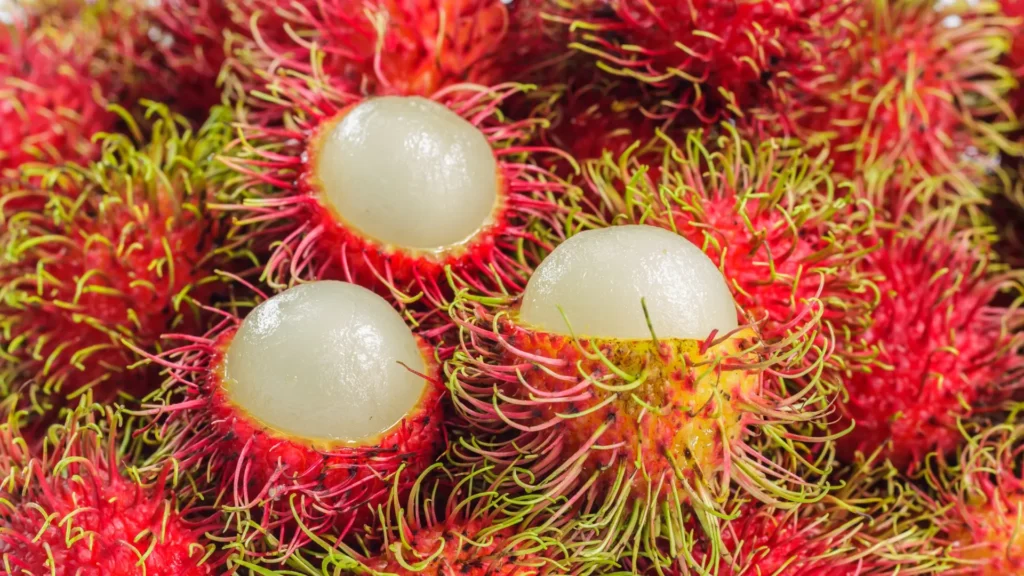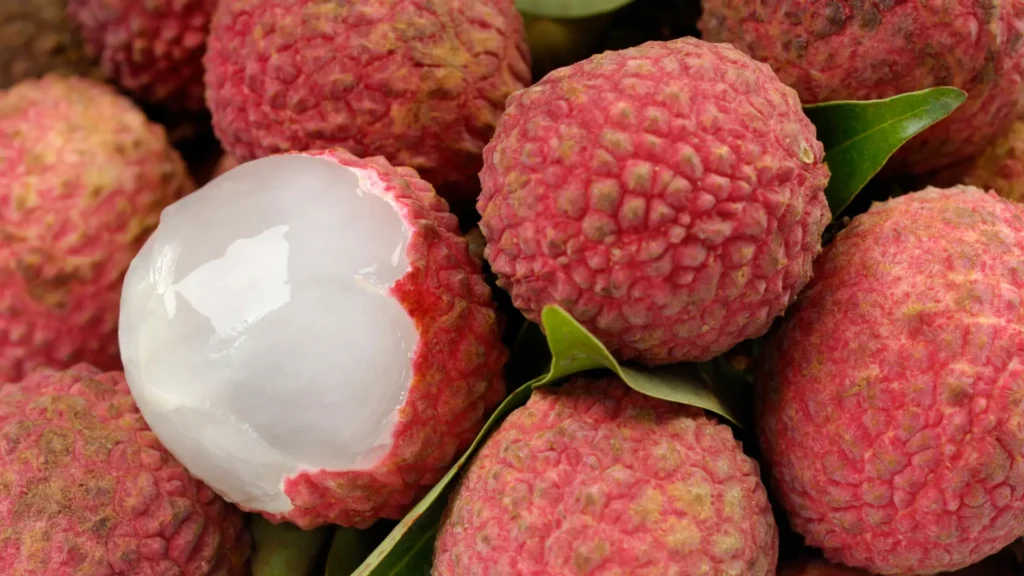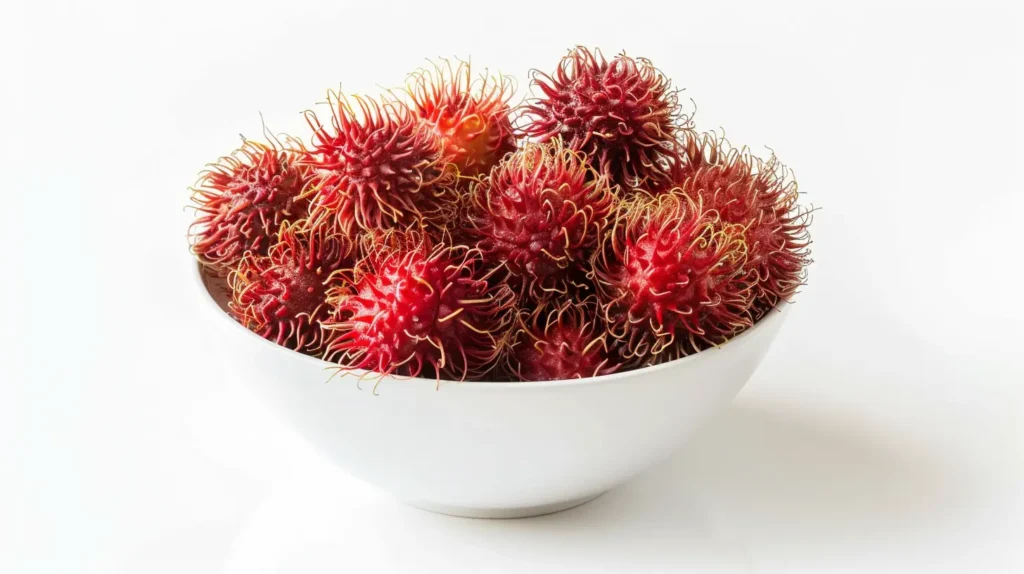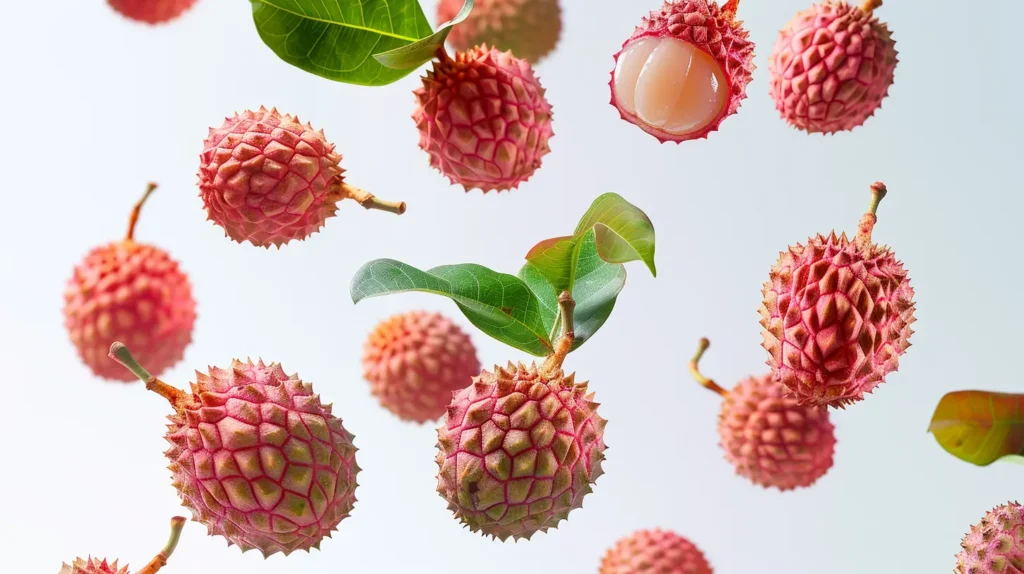Have you ever found yourself staring at the exotic fruit section of your local grocery store, wondering about the strange, spiky red fruits that look like they came straight out of a Dr. Seuss book? Chances are, you were looking at rambutans and lychees. The two tropical delights that have been captivating taste buds around the world for centuries. This brings us to the ultimate comparison: Rambutan vs Lychee, which is healthier?
At first glance, these peculiar fruits might seem like long-lost twins. They’re both small, red, and round, with a sweet, juicy flesh hidden beneath their unconventional exteriors. But don’t let their similarities fool you – rambutans and lychees each have their own unique personalities and quirks that set them apart.
Imagine biting into a rambutan, feeling the soft, hairy spines tickle your lips as you peel away the skin to reveal the translucent, grape-like fruit inside. Now picture yourself cracking open the thin, bumpy shell of a lychee to discover a fragrant, floral aroma and a crisp, succulent texture.
These two fruits may hail from the same tropical family tree, but they’ve each carved out their own special place in the hearts (and mouths) of fruit lovers everywhere. From their native roots in Southeast Asia and southern China to their starring roles in everything from cocktails to desserts, rambutans and lychees have become global ambassadors of exotic flavor.
So, what exactly sets these two apart? Is it their appearance, their taste, or perhaps their nutritional profile? In this article, we will be comparing Rambutan vs Lychee. Join us as we embark on a flavorful journey to uncover the secrets behind the rambutan and the lychee.
Rambutan vs Lychee: Origins and Classification
Before we start comparing Rambutan vs Lychee, we need first want to find out about the origins of both fruits.
While the rambutan and lychee may seem like long-lost twins, they actually have quite different backgrounds. Rambutan hails from the tropical regions of Indonesia and Malaysia, where it’s been growing wild since ancient times. It’s part of the Nephelium genus in the Sapindaceae family, which is also known as the soapberry family.
The name “rambutan” comes from the Malay word “rambut,” which means “hair.” And it’s no wonder – this fruit is covered in soft, hairy spines that give it a unique and slightly intimidating appearance. But don’t let that fool you – beneath that prickly exterior lies a sweet, juicy treat.
Lychee, on the other hand, originated in southern China, possibly spreading to northern Vietnam and the Malay Peninsula. It belongs to the Litchi genus, which is also part of the Sapindaceae family. So while rambutan and lychee are cousins, they’re not as closely related as you might think.
The lychee has a much longer recorded history than the rambutan. Chinese records mention the fruit as far back as 2000 BC, and it’s been a favorite of Chinese emperors for centuries. In contrast, the rambutan didn’t start spreading beyond its native region until the 13th to 15th centuries, when Arab traders introduced it to places like Zanzibar and other parts of East Africa.
Here’s a quick breakdown of the classification for each fruit:
| Rambutan | Lychee |
|---|---|
| Kingdom: Plantae | Kingdom: Plantae |
| Phylum: Magnoliophyta | Phylum: Magnoliophyta |
| Class: Magnoliopsida | Class: Magnoliopsida |
| Order: Sapindales | Order: Sapindales |
| Family: Sapindaceae | Family: Sapindaceae |
| Genus: Nephelium | Genus: Litchi |
| Species: N. lappaceum | Species: L. chinensis |
So while these two fruits may look similar and share a common ancestor, they’ve each got their own unique history and identity. In the next section, we’ll take a closer look at how their appearances set them apart.
Rambutan vs Lychee: Appearance
At first glance, you might think rambutan and lychee are long-lost twins separated at birth. But if you take a closer look, you’ll notice some distinct differences in their appearance that give each fruit its own unique charm.

Rambutan is like the quirky, attention-seeking sibling with its wild, hairy exterior. This tropical fruit is covered in soft, flexible spines that give it a striking resemblance to a sea urchin or a tiny red monster. The spines can range in color from bright red to yellow-orange, depending on the variety. Rambutan is also the bigger of the two, typically measuring between 3 to 6 cm in length.

Lychee, on the other hand, is like the more refined, elegant sibling. Its thin, textured skin is a pretty pink or red hue that’s sure to catch your eye. The skin has a bumpy, leather-like appearance, but don’t let that fool you – it’s actually quite delicate and easy to peel. Lychee is smaller than rambutan, usually around 2 to 5 cm in diameter.
But the real magic happens when you peel back the skin of these fruits. Both rambutan and lychee have translucent white flesh that’s incredibly juicy and succulent. The flesh surrounds a single brown seed in the center, which can vary in size depending on the variety.
Here’s a quick comparison of their appearance:
| Feature | Rambutan | Lychee |
|---|---|---|
| Size | 3-6 cm long | 2-5 cm in diameter |
| Skin texture | Soft, hairy spines | Thin, bumpy, leather-like |
| Skin color | Bright red, yellow-orange | Pink, red |
| Flesh color | Translucent white | Translucent white |
| Seed | Single, brown | Single, brown |
So while they may look like they belong to the same family tree, their unique appearances set them apart as two distinct and equally delightful tropical treats. Whether you prefer the wild and wacky look of rambutan or the more demure and sophisticated appearance of lychee, both fruits are sure to impress with their exotic beauty.
Rambutan vs Lychee: Taste and Texture
When it comes to taste and texture, rambutan and lychee have some similarities but also distinct differences that set them apart.
Rambutan Taste & Texture

Let’s start with rambutan. When you bite into the juicy white flesh of a rambutan, you’ll be greeted with a burst of sweet, slightly floral flavor. Some people describe the taste as a cross between a grape and a strawberry, with a hint of tartness that balances out the sweetness. The texture of rambutan flesh is often compared to a grape – it’s juicy and aqueous, with a crisp and clean mouthfeel. Some varieties of rambutan may have a creamier texture.
Lychee Taste & Texture

Lychee, on the other hand, has a flavor profile that’s often described as a delicate balance of sweet and tart. The sweetness is similar to that of a ripe pear or grape, while the tartness is reminiscent of a citrus fruit. Lychee also has a subtle floral aroma that adds depth to its overall taste. When it comes to texture, lychee flesh is translucent and gelatinous, with a consistency similar to a peeled grape. It’s juicy and tender, with a slightly firmer bite than rambutan.
Here’s a quick comparison of the taste and texture of rambutan and lychee:
| Fruit | Taste | Texture |
|---|---|---|
| Rambutan | Sweet, slightly floral, hint of tartness | Juicy, aqueous, crisp, clean, sometimes creamy |
| Lychee | Sweet, tart, subtle floral aroma | Translucent, gelatinous, juicy, tender, slightly firmer than rambutan |
It’s worth noting that the exact flavor profile of both rambutan and lychee can vary depending on factors like the specific variety, ripeness, and growing conditions. Some rambutans may be sweeter or more tart than others, while lychees can range from delicately sweet to more assertively floral.
Ultimately, the best way to experience the unique tastes and textures of rambutan and lychee is to try them for yourself. Whether you prefer the crisp sweetness of rambutan or the juicy delicacy of lychee, these tropical fruits offer a delightful sensory experience that’s sure to tantalize your taste buds.
Rambutan vs Lychee: Nutritional Comparison
When it comes to the battle of the tropical fruits, rambutan and lychee have a lot in common nutritionally. But there are a few key differences that might sway you towards one or the other.
Calories & Macronutrients
Let’s start with the basics – calories and macronutrients. A one-cup serving of rambutan contains about 123 calories, while the same amount of lychee clocks in at around 66 calories. So if you’re watching your calorie intake, lychee might be the way to go.
In terms of carbs, rambutan has about 31 grams per cup, while lychee has around 16.5 grams. Both fruits are relatively low in protein and fat, with less than 1 gram of each per serving.
Fiber Content
But where lychee really shines is in its fiber content. A cup of lychee provides about 1.3 grams of fiber, while rambutan only has about 1.4 grams. Fiber is important for keeping your digestive system running smoothly and can help you feel full and satisfied after eating.
When it comes to vitamins and minerals, lychee takes the lead. It’s an excellent source of vitamin C, providing over 70 milligrams per cup. That’s almost 80% of the daily recommended intake for adults. Lychee is also a good source of copper, potassium, and magnesium.
Rambutan, on the other hand, is a bit lower in vitamin C, with about 30 milligrams per cup. But it does contain small amounts of other important nutrients like calcium, iron, and zinc.
Here’s a quick comparison of the nutritional content of one cup of rambutan versus one cup of lychee:
| Nutrient | Rambutan (1 cup) | Lychee (1 cup) |
|---|---|---|
| Calories | 123 | 66 |
| Carbs | 31.3 g | 16.5 g |
| Fiber | 1.4 g | 1.3 g |
| Protein | 1 g | 0.8 g |
| Fat | 0.3 g | 0.4 g |
| Vitamin C | 30 mg | 71.5 mg |
| Copper | 0.2 mg | 0.1 mg |
| Potassium | 277 mg | 171 mg |
| Magnesium | 12 mg | 10 mg |
So while both fruits are nutritious choices, lychee comes out slightly ahead in terms of its vitamin and mineral content. But rambutan is still a healthy option, especially if you’re looking for a slightly sweeter and creamier fruit.
Ultimately, the best choice comes down to your personal taste preferences and nutritional needs. Why not try both and see which one you like best? Your taste buds (and your body) will thank you.
Rambutan vs Lychee: Culinary Uses
Rambutan and lychee are incredibly versatile fruits that can be used in a wide range of sweet and savory dishes. Their unique flavors and textures make them a favorite among chefs and home cooks alike.
One of the most popular ways to enjoy rambutan and lychee is in desserts. Their sweet, floral notes pair beautifully with creamy ingredients like ice cream, pudding, and panna cotta. You can also use them to make refreshing sorbets and granitas, perfect for a hot summer day.
Rambutan and lychee also make excellent additions to cocktails and mocktails. Muddle them with mint and lime for a tropical twist on a mojito, or blend them with vodka and ice for a fruity martini. You can even use the syrup from canned lychees to sweeten drinks and add a subtle floral flavor.
But these fruits aren’t just for sweet treats. Rambutan and lychee can also be used in savory dishes, particularly in Asian cuisine. They pair well with spicy flavors like chili and ginger, and can be used to balance out rich, meaty dishes like curries and stir-fries.
Fun Cooking Ideas
Here are a few ideas for incorporating rambutan and lychee into your cooking:
- Make a refreshing salad with fresh greens, sliced rambutan or lychee, and a tangy vinaigrette
- Use them as a topping for pavlova or meringue, along with whipped cream and other tropical fruits
- Stuff them with cream cheese or mascarpone for an elegant appetizer or dessert
- Add them to a stir-fry with chicken, shrimp, or tofu for a sweet and savory dish
- Simmer them in coconut milk with spices like cinnamon and cardamom for a fragrant dessert soup
No matter how you choose to use them, rambutan and lychee are sure to add a unique and delicious flavor to your dishes. So next time you see them at the market, don’t be afraid to experiment and try something new!
Rambutan vs Lychee: Give the a Try!
Rambutan and lychee are two fascinating tropical fruits that share many similarities but also have their own unique characteristics. From their origins in Southeast Asia and southern China to their distinct appearances and flavors, these fruits offer a delightful sensory experience for those who enjoy trying new and exotic produce.
So, whether you prefer the sweet, juicy taste of rambutan or the delicate, floral notes of lychee, these tropical fruits are definitely worth exploring. Next time you see them at your local market or specialty store, don’t hesitate to give them a try. Your taste buds will thank you for the delicious adventure!
Today we talked about Rambutan vs Lychee and how it compares. Here are some other articles you might like:
Running vs Walking: Which Is Better for Weight Loss?
Diet or Exercise: Which is better for losing weight?
What are the Most Unhealthy Fruits?
Rambutan vs Lychee: What you need to know
What are the Best Fruits for Muscle Growth?
Are Bananas good for Muscle Recovery?



